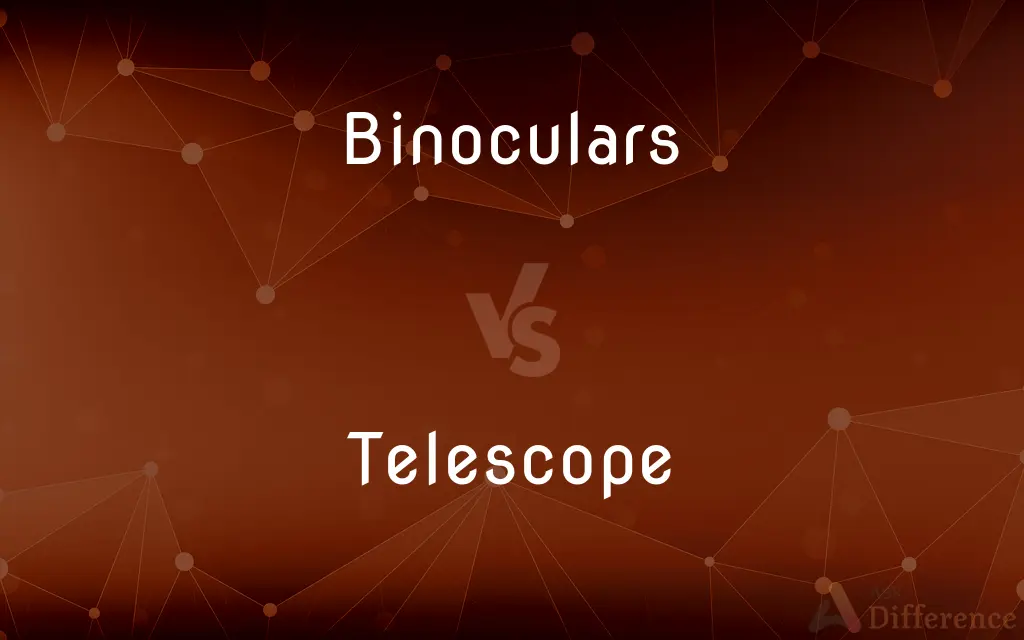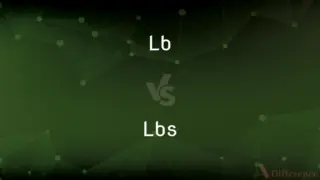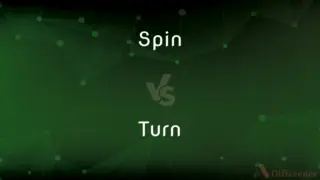Binoculars vs. Telescope — What's the Difference?
By Maham Liaqat & Urooj Arif — Updated on May 15, 2024
Binoculars are portable, dual-lens devices for wide-field observation, ideal for general use, while telescopes are single-lens instruments designed for detailed, long-distance viewing, primarily used in astronomy.

Difference Between Binoculars and Telescope
Table of Contents
ADVERTISEMENT
Key Differences
Binoculars are handheld optical devices that use two parallel lenses to provide a three-dimensional view. They are ideal for activities requiring mobility and a wide field of view, such as bird watching, sports events, and general outdoor observation. Telescopes, on the other hand, use a single, often larger lens or mirror to magnify distant objects, making them better suited for detailed, long-range observation, particularly in astronomy.
Binoculars offer lower magnification compared to telescopes but compensate with greater ease of use and portability. They provide a stereoscopic view, meaning each eye receives a slightly different image, creating a perception of depth. Telescopes provide higher magnification, which is crucial for viewing celestial bodies but require a stable mount and are generally more cumbersome.
The field of view in binoculars is typically wider, allowing users to observe larger areas at once. This makes them excellent for scanning landscapes or tracking moving objects. Telescopes have a narrower field of view, focusing on small, distant details, which is perfect for studying specific celestial objects like planets, stars, and galaxies.
Binoculars are more versatile and user-friendly, often featuring adjustable lenses and image stabilization to enhance the viewing experience. Telescopes usually demand more setup and calibration, with various types (refracting, reflecting, and compound) each tailored to specific observational needs.
Comparison Chart
Optical Design
Dual-lens, stereoscopic
Single-lens or mirror
ADVERTISEMENT
Magnification
Lower, typically up to 10x-20x
Higher, often 50x or more
Portability
High, easy to carry
Low, requires stable setup
Field of View
Wide, ideal for general observation
Narrow, ideal for detailed observation
Use Case
Bird watching, sports, general outdoor use
Astronomy, detailed long-range viewing
Compare with Definitions
Binoculars
Easy to carry and use for various activities.
I always bring my binoculars on hiking trips for bird watching.
Telescope
Requires a stable mount for clear viewing.
Setting up a telescope involves securing it on a tripod for stability.
Binoculars
Provides a sense of depth and 3D perception.
The stereoscopic view in binoculars enhances the experience of watching sports.
Telescope
Optical device using one lens or mirror.
A telescope's single-lens setup allows for high magnification of distant objects.
Binoculars
Covers a large area at once.
Binoculars' wide field of view helps track moving objects easily.
Telescope
Primarily used for studying celestial bodies.
Telescopes are essential tools for amateur and professional astronomers.
Binoculars
Optical instrument with two lenses for each eye.
The dual-lens design of binoculars makes them perfect for wildlife observation.
Telescope
Capable of enlarging distant objects significantly.
Telescopes provide the high magnification needed to observe planets.
Binoculars
Suitable for multiple activities beyond stargazing.
Binoculars are versatile tools for both day and night activities.
Telescope
A telescope is an optical instrument using lenses, curved mirrors, or a combination of both to observe distant objects, or various devices used to observe distant objects by their emission, absorption, or reflection of electromagnetic radiation. The first known practical telescopes were refracting telescopes invented in the Netherlands at the beginning of the 17th century, by using glass lenses.
Binoculars
Binoculars or field glasses are two refracting telescopes mounted side-by-side and aligned to point in the same direction, allowing the viewer to use both eyes (binocular vision) when viewing distant objects. Most binoculars are sized to be held using both hands, although sizes vary widely from opera glasses to large pedestal-mounted military models.
Telescope
An arrangement of lenses or mirrors or both that gathers light, permitting direct observation or photographic recording of distant objects.
Binoculars
Relating to, used by, or involving both eyes at the same time:binocular vision.
Telescope
Any of various devices, such as a radio telescope, used to detect and observe distant objects by their emission, absorption, or reflection of electromagnetic radiation.
Binoculars
Having two eyes arranged to produce stereoscopic vision.
Telescope
To cause to slide inward or outward in overlapping sections, as the cylindrical sections of a small hand telescope do.
Binoculars
OftenbinocularsAn optical device, such as a pair of field glasses or opera glasses, designed for simultaneous use by both eyes and consisting of two small telescopes joined together.
Telescope
To make more compact or concise; condense.
Binoculars
A hand-held device consisting of a series of lenses and prisms, used to magnify objects so that they can be better seen from a distance, and looked at through both eyes.
Telescope
To slide inward or outward in or as if in overlapping cylindrical sections
A camp bucket that telescopes into a disk.
Binoculars
An optical instrument designed for simultaneous use by both eyes
Telescope
A monocular optical instrument that magnifies distant objects, especially in astronomy.
Telescope
Any instrument used in astronomy for observing distant objects (such as a radio telescope).
Telescope
(television) A retractable tubular support for lights.
Telescope
(ambitransitive) To extend or contract in the manner of a telescope.
Telescope
(ambitransitive) To slide or pass one within another, after the manner of the sections of a small telescope or spyglass.
Telescope
(intransitive) To come into collision, as railway cars, in such a manner that one runs into another.
Telescope
To collapse, via cancellation.
Telescope
An optical instrument used in viewing distant objects, as the heavenly bodies.
Telescope
To slide or pass one within another, after the manner of the sections of a small telescope or spyglass; to come into collision, as railway cars, in such a manner that one runs into another; to become compressed in the manner of a telescope, due to a collision or other force.
Telescope
To cause to come into collision, so as to telescope.
Telescope
To shorten or abridge significantly; as, to telescope a whole semester's lectures into one week.
Telescope
Capable of being extended or compacted, like a telescope, by the sliding of joints or parts one within the other; telescopic; as, a telescope bag; telescope table, etc.; - now more commonly replaced by the term telescoping.
Telescope
A magnifier of images of distant objects
Telescope
Crush together or collapse;
In the accident, the cars telescoped
My hiking sticks telescope and can be put into the backpack
Telescope
Make smaller or shorter;
The novel was telescoped into a short play
Telescope
Focuses on small, distant areas.
Telescopes have a narrow field of view, ideal for focusing on specific stars.
Common Curiosities
What are binoculars primarily used for?
Binoculars are used for general outdoor observation, including bird watching, sports, and nature viewing.
Can telescopes be used during the day?
Yes, telescopes can be used for daytime terrestrial observation, but they are primarily designed for astronomy.
What is a common use for telescopes?
Telescopes are commonly used for observing celestial bodies like stars, planets, and galaxies.
Why do telescopes require a stable setup?
Telescopes have high magnification, which makes them sensitive to movement, requiring a stable setup for clear viewing.
How do binoculars provide depth perception?
Binoculars use dual lenses to give each eye a slightly different view, creating a stereoscopic effect for depth perception.
Do binoculars have higher magnification than telescopes?
No, binoculars typically have lower magnification compared to telescopes.
Are telescopes portable?
Generally, telescopes are less portable than binoculars due to their size and the need for a stable mount.
Do binoculars require much setup?
No, binoculars are generally ready to use with minimal setup required.
What is the benefit of a stereoscopic view in binoculars?
A stereoscopic view provides depth perception and a more immersive experience.
Can telescopes be used for bird watching?
While possible, telescopes are not ideal for bird watching due to their narrow field of view and bulkiness.
What type of field of view do binoculars offer?
Binoculars offer a wide field of view, ideal for scanning large areas and tracking moving objects.
Can binoculars be used for stargazing?
Yes, binoculars can be used for stargazing, though they are less powerful than telescopes.
What types of telescopes exist?
There are refracting telescopes, reflecting telescopes, and compound telescopes.
How do telescopes achieve high magnification?
Telescopes use larger lenses or mirrors to gather more light and provide higher magnification.
Why are binoculars more versatile?
Binoculars are lightweight, easy to use, and suitable for a variety of activities.
Share Your Discovery

Previous Comparison
Lb vs. Lbs
Next Comparison
Spin vs. TurnAuthor Spotlight
Written by
Maham LiaqatCo-written by
Urooj ArifUrooj is a skilled content writer at Ask Difference, known for her exceptional ability to simplify complex topics into engaging and informative content. With a passion for research and a flair for clear, concise writing, she consistently delivers articles that resonate with our diverse audience.













































